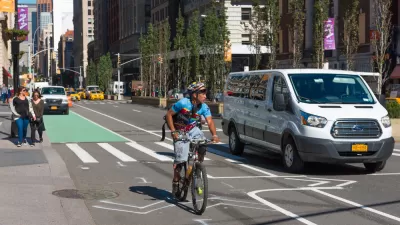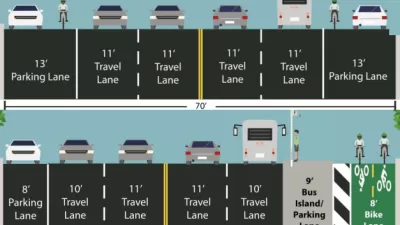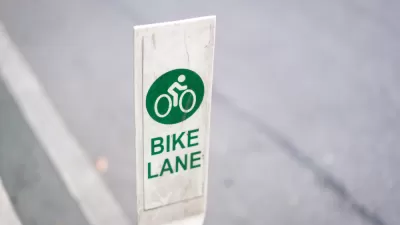A compromise road diet with “flex lanes” falls short of its promise.

A newly installed New York City bike lane “seems to be a matter of interpretation,” writes Clio Chang in Curbed. “Riding the route on a Tuesday in late October, I watched as bikes, mopeds, scooters, and cars all vied for space in the freshly painted lane, all of them maneuvering around the half a dozen vehicles that had decided to use it as parking.”
Chang explains that the city proposed a road diet for the dangerous stretch of McGuinness Boulevard in May. “The idea was to cut four lanes of traffic down to two and add bike lanes that would be protected by a parking lane–slash–pedestrian island. That was, until local businesses — led by the powerful Argento film-production family — launched a well-financed campaign they called ‘Keep McGuinness Moving.’”
The redesign that was implemented includes two “flex lanes” that turn into parking lanes at night, the proposed loading zones are gone, and the former parking lane serves as a bike lane—though Chang observed multiple cars parked in it. “While there were already a mix of barriers installed between the bike and traffic lanes, there was still space for cars to park.” The Department of Transportation says they are installing more barriers to prevent cars from using the bike lane.
Chang points out that this isn't the first time Mayor Adams has caved to pressure on road safety issues. The mayor, writes Chang, “has walked back a number of street-safety plans in the past year, such as the scrapped offset bus lanes in the Bronx and, more recently, the nearly completed redesign on Underhill, now allegedly paused.”
FULL STORY: Welcome to the McGuinness Boulevard Parking Lot–Bike Lane–Loading Zone

Planetizen Federal Action Tracker
A weekly monitor of how Trump’s orders and actions are impacting planners and planning in America.

Maui's Vacation Rental Debate Turns Ugly
Verbal attacks, misinformation campaigns and fistfights plague a high-stakes debate to convert thousands of vacation rentals into long-term housing.

Restaurant Patios Were a Pandemic Win — Why Were They so Hard to Keep?
Social distancing requirements and changes in travel patterns prompted cities to pilot new uses for street and sidewalk space. Then it got complicated.

In California Battle of Housing vs. Environment, Housing Just Won
A new state law significantly limits the power of CEQA, an environmental review law that served as a powerful tool for blocking new development.

Boulder Eliminates Parking Minimums Citywide
Officials estimate the cost of building a single underground parking space at up to $100,000.

Orange County, Florida Adopts Largest US “Sprawl Repair” Code
The ‘Orange Code’ seeks to rectify decades of sprawl-inducing, car-oriented development.
Urban Design for Planners 1: Software Tools
This six-course series explores essential urban design concepts using open source software and equips planners with the tools they need to participate fully in the urban design process.
Planning for Universal Design
Learn the tools for implementing Universal Design in planning regulations.
Heyer Gruel & Associates PA
JM Goldson LLC
Custer County Colorado
City of Camden Redevelopment Agency
City of Astoria
Transportation Research & Education Center (TREC) at Portland State University
Jefferson Parish Government
Camden Redevelopment Agency
City of Claremont





























